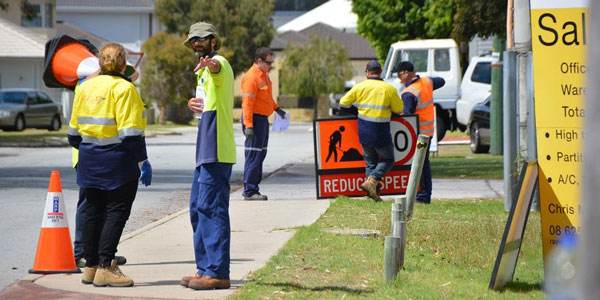Traffic Controller Requirements for Safe and Productive Sites
Compared to normal road operations, roadwork sites are particularly hazardous for all road users. Traffic controllers provide traffic control services for personal safety, public convenience and job management when signs and roadwork devices are insufficient.
Traffic controllers are critical to productivity, safety and success on roadwork sites. As frontline representatives of organisations, traffic controllers need to carry out all work to certain high standards – as detailed in Main Roads Western Australia’s Traffic Controllers’ Handbook.
The Seven Requirements
Be Properly Dressed and Prepared
Being properly dressed and prepared shows respect for yourself and your job while increasing respect and recognition from motorists and road users. Traffic controllers’ high visibility clothing must comply with AS/NZS 1906.4 and AS/NZS 4602 for Types D, N or D/N. Safety footwear must comply with AS/NZS 2210 – Occupational Protective Footwear and you may be required to wear a Type N garment for night works.
Understand Your Authority and Responsibilities
All traffic controllers must have successfully completed a ‘Traffic Controller’ course provided by an MRWA accredited training provider. Traffic controllers must also hold a current accreditation and need to be re-accredited every three years.
Warp Training Australia provides a number of accredited traffic controller courses delivered by experienced, qualified and specialised professionals. WTA’s courses equip you with the skills, knowledge and practical know-how to enter the workforce with confidence.
View the full Main Roads Western Australia’s Traffic Controllers’ Handbook for complete guidelines on authority and responsibility.
Know the Correct Procedures
As a traffic controller, you must have a thorough understanding of correct procedures. Hand-held ‘STOP’ and ‘SLOW’ signs can be mounted back-to-back on a timber or aluminium pole. The bottom of the sign should be 1.8m from the bottom of the pole. The diameter of the disc is generally 600mm.
For more on traffic control protocol and requirements, refer to the Main Roads Western Australia’s Traffic Controllers’ Handbook.
Be Properly Located
Traffic controllers must be clearly seen. Do not stand in shady or dusty areas or areas where the sun may obstruct you or the on-coming driver’s vision. When possible, stand where you can see both ends of the work area (your end and the end where the other traffic controller is positioned). Traffic Controllers must also make sure that they have an escape route in case a vehicle appears not to be stopping.
Communicate Effectively
Communicating directions
- Use the hand-held ‘STOP/SLOW’ sign
- Use positive hand signals (see section 3.4)
- Communicate confidently
- Utilise eye contact with drivers
- Present yourself neatly and professionally
- Demonstrate an engaged and interested work ethic
Communicating with the public
- Remember your position as a frontline representative
- Be polite and brief if asked questions or when giving verbal directions
- Make accurate statements
- Avoid jargon
- Never engage in arguments or use abusive or impolite language
Communicating internally with portable two-way radios
- Ensure you know what channel you are on
- Speak clearly and accurately
- Provide enough clear and concise information for other traffic controllers
- Establish standard messages
- Keep dialogue to a minimum
Assess Changes in Traffic Patterns
Traffic controllers should be alert to changing conditions and traffic patterns. Regular assessments should be made, including:
- Consideration of sun angles that may result in a shaded traffic control station or hard-to-read signs for drivers
- Poorly set up, vandalised, damaged, blown over, old or dirty signs
- Peak hour traffic and road users
- Staying alert for near misses, which may indicate a problem
- Communicating with supervisors if problems are suspected
Know Emergency Procedures
As a traffic controller, how you respond in an emergency is important. If a crash occurs, never leave your post unless your own safety is threatened. Warn co-workers and your supervisor as soon as possible, secure traffic behind the incident, radio for assistance and follow instructions.
If incident reports are required, ensure that you complete them thoroughly and accurately.
For incidents involving hazardous loads, you need to take extra care. Alert your supervisor and follow instructions to evacuate the area. Implement the appropriate emergency action plan and cooperate with further instructions from your supervisor and authorities.
Traffic Management Training in Perth
Warp Training Australia offers a variety of traffic management training courses in Perth. As an MRWA accredited training provider, we equip students with relevant industry skills, expertise and practical knowledge in traffic control.
Become an accredited traffic controller with Warp Training Australia. Find out more about courses today.
Contact WARP Group Today
WARP Group provides comprehensive traffic management services for projects of all sizes in Perth. To find out more about accredited traffic control training courses in Perth, contact Warp Training Australia on 1300 019 304.





